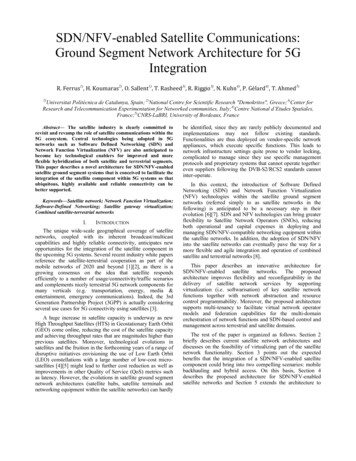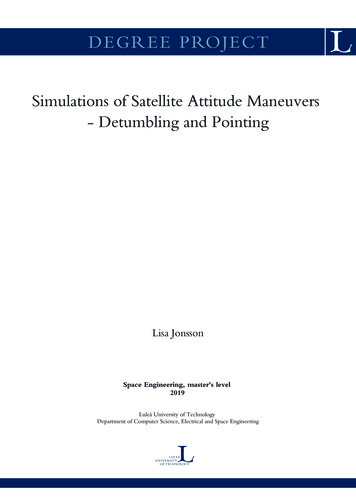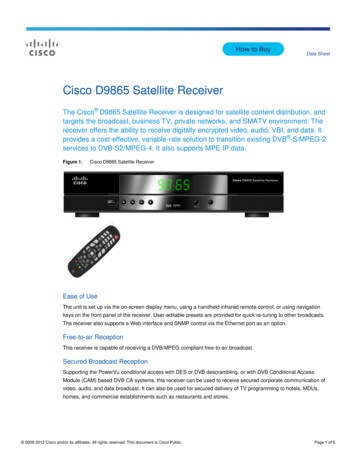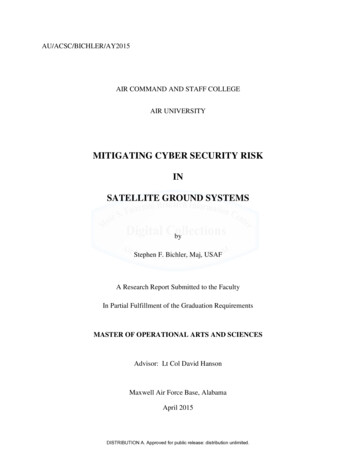
Transcription
IWSSC 2008 TutorialSatellite Networks I: constellationsorbital types, uses and advantagesLloyd Wood, Cisco Systemscreated withInternational Workshop on Satellite and SpaceCommunications 2008, IWSSC 2008,1 October 2008, Toulouse, Francesavi.sf.net
Who am I? What’s my perspective? Did masters project on satellite constellationswith intersatellite links, at ENST Toulouse. Did PhD on same at University of Surrey. Went to program router code for Cisco Systems. Later moved into their new space team. Tested Cisco mobile Internet router in space onUK-DMC satellite, working with Surrey SatelliteTechnology Ltd and NASA Glenn.– My team was first to test IPv6 in space – and first to use the ‘bundle protocol’ in space. I’m networking-oriented. Not a channel guy!
One reason my PhD took so long
All orbits are ellipses Kepler’s first lawEarth mass M at focus ofan ellipse. Circular orbit isjust a ‘special case’ of theellipse, where the two fociiare positioned together toform one. Kepler’s second lawequal areas covered inequal times. Kepler’s third lawcircular orbits (T2œr3) arethe most useful for us.slow nearapogeeMfast nearperigeeImages from other organisations are used with attribution and thanksWikipedia
How to describe an orbit?Two-line element (TLE) format designed byNORAD, introduced November 1972.NORAD# Int. Desig. epoch of TLE1st/2nd mean motion deriv. dragorbital model to use1 NNNNNC NNNNNAAA NNNNN.NNNNNNNN .NNNNNNNN NNNNN-N NNNNN-N N NNNNN2 NNNNN NNN.NNNN NNN.NNNN NNNNNNN NNN.NNNN NNN.NNNN NN.NNNNNNNNNNNNNNNORAD# orbital elements (inc, RAAN, e, arg. p., mean an.) mean motion revs. info126th dayINTELSAT 5061 14077U 83047A 97126.05123843 -.00000246 00000-0 10000-3 0 7212 14077 5.1140 60.2055 0003526 327.1604 183.6670 1.00269306 18589weak one-digitline checksums.year of epoch. TWO-DIGIT. NOT Y2K COMPLIANT!But claimed good until 2056.year of launch,before ID in year.Sample FORTRAN code can be found.
Most useful for communications –geostationary Earth orbit (GEO) Altitude (35786km) chosenso that satellite moves atsame angular velocity asEarth’s rotation, so appearsstill. (period: 1 sidereal day.) Three satellites spacedequally around the Equatorcan see most of the Earth –but not the poles.(Arthur C. Clarke, 1945)
Most useful for communications –geostationary Earth orbit (GEO) Altitude (35786km) chosenso that satellite moves atsame angular velocity asEarth’s rotation, so appearsstill. (period: 1 sidereal day.) Three satellites spacedequally around the Equatorcan see most of Earth – butnot the poles.(Arthur C. Clarke, 1945) Inmarsat’s I-4 BGAN isnearest match to this. Thirdsat launched 18 Aug 2008.BBC
Intersatellite links are an old idea commonly written as ISLs but interconnecting geostationary satellites is still cutting-edge stuff.Fig 3 from Extra-Terrestrial Relays, Arthur C. Clarke, Wireless World, 1945.
Satellite antennas tailor footprints Satellites don’t always support perfectly sphericalcoverage areas. Shaped spotbeams let you concentrate coverageand power where you want it. Movable antennas let you provide more support(traffic) to a region on demand.SatMex-5
Actual geostationary orbit use (2001)Solar panels aren’t wings Note gap over the Pacific – too large to span (unlike Atlantic); small populations.
Quick overview of Earth orbits Polar viewcomparesaltitudes as ifall orbits lie onEquator. Van Allen beltsand radiationenvironmentsimplified –solar windpushes themout of circular.
Inclined geosynchronous orbit Geostationary satellite reaches end of its plannedlife – stationkeeping fuel has run out, satellitemoves in the sky south/north of the Equator. Canbe used give a few hours’ connectivity cheaplyeach day for polar research stations. Forms a figure-of-eight groundtrack throughout theday. Investigated for use for mid-latitude Japan togive high-bandwidth comms with smaller footprints.
Useful highly elliptical orbits (HEO) Molnya (0.5sd 12hr) andTundra ( 24hr 1sd orbits)– cover high latitudes atapogee. Invented by Soviet military;then Russian satellitetelevision in 1960s. 63.4ºinclination.TundraYellow circular GEO orbit shown for scale
Useful highly elliptical orbits (HEO) Molnya (0.5sd 12hr) andTundra ( 24hr 1sd orbits)– cover high latitudes atapogee. Invented by Soviet military;then Russian satellitetelevision in 1960s. 63.4ºinclination.MolnyaYellow circular GEO orbit shown for scale
Useful highly elliptical orbits (HEO) Molnya (0.5sd 12hr) andTundra ( 24hr 1sd orbits)– cover high latitudes atapogee. Invented by Soviet military;then Russian satellitetelevision in 1960s. 63.4ºinclination. Sirius Radio adopted thismodel over the continentalUS, before merging withXM Radio, which had twogeostationary satellites.Yellow circular GEO orbit shown for scaleSirius Radio
Optimal elliptical constellation Four satellites providevisibility to the entireEarth (Draim, 1987). Earth always inside atetrahedron. Assumes Earth is flat –satellites often very lowabove horizon, easilyobscured. Not built. Huge 2sd 48-hrorbits with repeatinggroundtracks.
Optimal elliptical constellation Four satellites providevisibility to the entireEarth (Draim, 1987). Earth always inside atetrahedron. Assumes Earth is flat –satellites often very lowabove horizon, easilyobscured. Not built. Huge 2sd 48-hrorbits with repeatinggroundtracks.
Optimal elliptical constellation Four satellites providevisibility to the entireEarth (Draim, 1987). Earth always inside atetrahedron. Assumes Earth is flat –satellites often very lowabove horizon, easilyobscured. Not built. Huge 2sd 48-hrorbits with repeatinggroundtracks.
Ellipso – John E. Draim again Use of elliptical apogee toprovide service at thenorthern high polar regions. Circular MEO orbit coversequatorial areas. Coverage of south poor: ‘mybusiness plan can do withoutthe people on Easter Island.’– David Castiel, Wired 1.05 Business plan to sell voicetelephony. Oops. Not built.Merged into ICO.
Shadowing and urban canyons No. of satellites you cansee above horizon isdiversity.Galileo – lots of satellites in view.
Shadowing and urban canyons No. of satellites you cansee above horizon isdiversity. But buildings/trees blockyour view of the horizon,limiting the number ofsatellites you can see. Skyscrapers and urbancanyons mean no view ofthe sky (why Sirius Radioand XM Radio build cityGalileo – lots of satellites in view. if you’re not standing in a city street.repeaters).
Navigation constellations Galileo and GPS(and Glonass)need to have highsatellite diversity. You really need tosee at least foursatellites for aquick and accuratepositioning fix(including height).Galileo
Communication system capacity Multiple spotbeams let you reuse preciousfrequencies multiple times, increasing use. Reuse of frequencies by differentspotbeams over multiple satellitesincreases overall system capacity.ICO satellite footprint approximation
Communication system capacity Multiple spotbeams let you reuse preciousfrequencies multiple times, increasing use. Reuse of frequencies by differentspotbeams over multiple satellitesincreases overall system capacity.7-colour frequency reuseICO satellite footprint approximation
Spotbeams!huge fold-out9m 4 satelliteBroadband Global Area Network (BGAN)first launched November 2005Qinetiq
ThurayaSatphone servicelaunched October 200012m reflectorBoeing
Uplink and downlink choicesCan make a choice –where to go down?Another spotbeam?Intersatellite link?frequency-shift(down slightly)and lfunctionalityphysicalchannelflexibility123NETWORK LAYER:packet switchingto other payloadsincreases overallsatellite functionality.LINK LAYER:onboard handlingand conversion ofMAC restricts choiceof waveforms.PHYSICAL LAYER:bent pipe amplificationgives flexible radiochannel.traditional ‘bent-pipe’switching on groundcan lead to ‘double hops’decode tobaseband andclean up signalcould comedown usingentirely differentfrequency andwaveformnewer ‘onboard processing’gaining some acceptancewith different tradeoffs.
Globalstar vs Iridiumacross intersatellite links to satellitethat sees ground stationbent-pipeCDMA recombination.Uses diversity, but must complete linkin nearby ground stationonboard processingDoesn’t use CDMA or diversity.But doesn’t need a nearby groundstation; less ground infrastructure.
Globalstar coverageGlobalstar Inc.where its satellites can connect you to a local ground stationnotice Cuba – interdicted.
Walker star constellations Walker star geometry, basedon Adams/Rider ‘streets ofcoverage’. Best diversity atpoles, worst at Equator. Has orbital seam whereascending and descendingplanes pass each other andmust overlap. Circular orbits are mostuseful throughout the orbitalperiod – signal strengthremains consistent.satellitecoverageareasmotionrelative togroundstreet ofcoverageorbital seam(coverage overlapseven more)NFdescending satellitesascending satellites(moving away from north pole)(moving towards north pole)
Walker star constellations Walker star geometry, basedon Adams/Rider ‘streets ofcoverage’. Best diversity atpoles, worst at Equator. Has orbital seam whereascending and descendingplanes pass each other andmust overlap. Only operating example:Iridium (Voice telephony.Went through bankruptcyprotection 1999-2001.)orbital seam(coverage overlapseven more)NFdescending satellitesascending satellites(moving away from north pole)(moving towards north pole)
Walker star constellations Walker star geometry, basedon Adams/Rider ‘streets ofcoverage’. Best diversity atpoles, worst at Equator. Has orbital seam whereascending and descendingplanes pass each other andmust overlap. Only operating example:Iridium (Voice telephony.Went through bankruptcyprotection 1999-2001.)orbital seam
Ballard rosette (also Walker delta) Best diversity at midlatitudes. Usually no coverage atpoles; not global. Only operating LEOexample: Globalstar(Voice telephony.Also went through USbankruptcy protectionafter Iridium did,2002-2004.)Nno orbital seam;ascending and descending satellites overlap
Ballard rosette (also Walker delta) Best diversity at midlatitudes. Usually no coverage atpoles; not global. Only operating LEOexample: Globalstar(Voice telephony.Also went through USbankruptcy protectionafter Iridium did,2002-2004.)ascending and descending satellites overlap
A star is a rosette cut in half11ascending satellitesdescending satellites2constellations offsetslightly for clarityorbital seamTopologically speaking, a rosette is a torus mapped onto a sphere;a Walker star is half a torus stitched onto a sphere.A star has one surface of satellites over the Earth, a rosette, two.
Globalstar Inc. vs Iridium SatelliteCompare Q2 2008 results for three months ending 30 June.Globalstar Inc.Iridium Satellitesubscribers 316,000280,000revenue 16.7 million 82 millionEBITDA( 2 million) loss 26 millionnewsatellitescurrently being integrated andtested by Thales Alenia Space.Iridium NEXT downselectedto: Thales Alenia Space,Lockheed Martin.Both are planning replacement constellationsas existing satellites near end of life. 20% of Iridium Satellite’s profits is from polar regions.Globalstar Inc. spent 1.1 million buying Brazilian gateway operator.
The incredible shrinking Teledesic 1994: 840 satellites –announced the largestnetwork system ever.
The incredible shrinking Teledesic 1994: 840 satellites –announced the largestnetwork system ever. Until 1997: planned 288satellites. Still biggest!
The incredible shrinking Teledesic 1994: 840 satellites –announced the largestnetwork system ever. Until 1997: planned 288satellites. Still biggest! Also most intersatellitelinks; redundant mesheven crossing the seam.
The incredible shrinking Teledesic 1994: 840 satellites –announced the largestnetwork system ever. Until 1997: planned 288satellites. Still biggest! Also most intersatellitelinks; redundant mesheven crossing the seam. Until 2002, down to thirtyMEO satellites Then bought ICO Global(which planned ten MEOsats for telephony; no ISLsand only one in orbit.)ICO bankruptcy protection: 1999-2000
New kid on the block: Google.Needs satellite imagery for GoogleMaps and Google Earth. Gets 4mresolution imagery from GeoEye-1(launched 6 Sep 2008). 0.5m imagery is restricted.Funding O3b Networks, along withHSBC, others. O3b aims to backhaulAfrican cellular networks via MEO ringof satellites covering 45o-45o latitude.GeoEye
Continuous coverage only neededfor continuous communication Orbcomm is a ‘little LEO’constellation for simplemessaging. Satellitesare just simple VHFrepeaters. Messagedelivered to groundstation when satellite isin view. Store and forward – buthere it’s at the sender,not on the satellite. and US bankruptcy protection 2000-2001.
Some views of intersatellite links Iridium has 10Mbps Ka-band radio crosslinks. ESA plans backhauling LEO remote sensingsatellites. Demonstrated with SILEX laserlong-distance crosslink and Artemis Ka-band. US DoD wants reachback to CONUS fromtheatre. Building TSAT TransformationalSatellites – five geostationary satellites withlong-distance laser crosslinks. Clustering and slot clouds short-distancewireless connecting stationkeeping satellites.
LEO remote sensing satellites LEO sun-synchronous orbits (inclinationvaries with altitude) are very useful; satelliteascends over the Equator at the same timeevery day everywhere on Earth. Makes iteasier to calibrate, correct and compare yourimages, e.g Landsat and the growingcommercial imaging market. Also GEO imaging satellites for wide-areaweather patterns, e.g. Meteosat. Triana – Al Gore proposed imaging fromEarth-Sun Lagrange L1 point.
Disaster Monitoring Constellation Single plane of four activesun-synchronous imagingsatellites, ascending at10:15am over Equator.Fifth satellite at 10:30am. Gives overlapping dailycoverage of any point onthe Earth’s surface. Coverage map shows600km pushbroomimaging swath – large byLEO imaging standards.More to be launchedImagingComms
Disaster Monitoring Constellation Single plane of four activesun-synchronous imagingsatellites, ascending at10:15am over Equator.Fifth satellite at 10:30am. Gives overlapping dailycoverage of any point onthe Earth’s surface. Communications access alittle larger – passes overground stations 14 min. RapidEye (5 sats launched29 August 2008) similar.Comms
www.dmcii.comSample Disaster Monitoring Constellation (DMC) imageThe Cape of Good Hope and False Bay. False colours – red is vegetation.Taken by UK-DMC satellite on the morning of Wednesday, 27 August 2008.First sensor imagery delivered by bundles from space.
Other sensing satellites Radar imaging satellites areactive, not passive sensors. They don’t have thedaytime restrictions ofimaging satellites – butnight is still a strain onbatteries. So these can be sunsynchronous at dawn anddusk – riding the day/nightterminator, solar cellsalways in sunlight.
Sensing benefits from ISLs backhauling through GEO to give longerperiods of connectivity to download data, e.g.half an hour instead of ten minutes. Synchronising payloads on different sensorsatellites, so that measurements taken at thesame time can be combined.– 3D stereoscopic imaging– Wide-aperture phased-array sensing– combined hyperspectral imaging, e.g. combining the capabilities of the climate-sensing ‘A-train’.– scientific measurements otherwise not possible, e.g. GRACE gravity measurement (launched March 2002).
SummaryThis talk has outlined: An overview of satellite orbits and coverage. A number of satellite constellation designs Their varied advantages, uses, and tradeoffs. Intersatellite links and design choices. Business plans using constellations – thesuccessful and unsuccessful ones. A boom-and-bust cyclical industry.
created withsavi.sf.netQuestions?ThankyouLloyd Woodhttp://info.ee.surrey.ac.uk/L.Wood/oh, just google
Globalstar Inc. vs Iridium Satellite Both are planning replacement constellations as existing satellites near end of life. 20% of Iridium Satellite's profits is from polar regions. Globalstar Inc. spent 1.1 million buying Brazilian gateway operator. Compare Q2 2008 results for three months ending 30 June. EBITDA ( 2 million) loss 26 million










